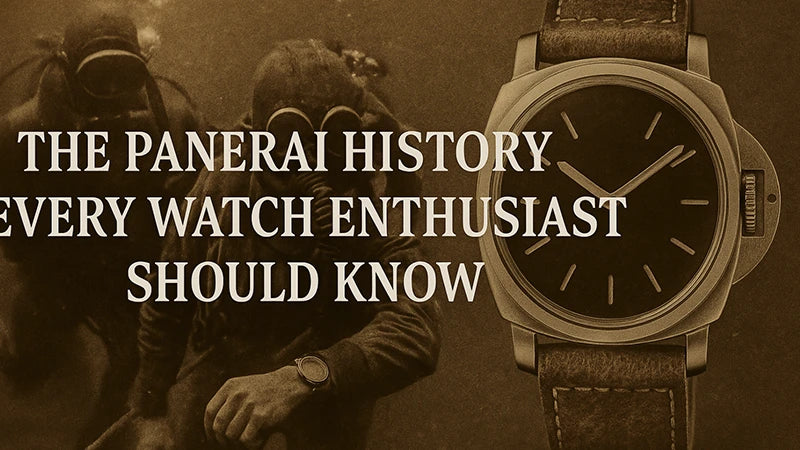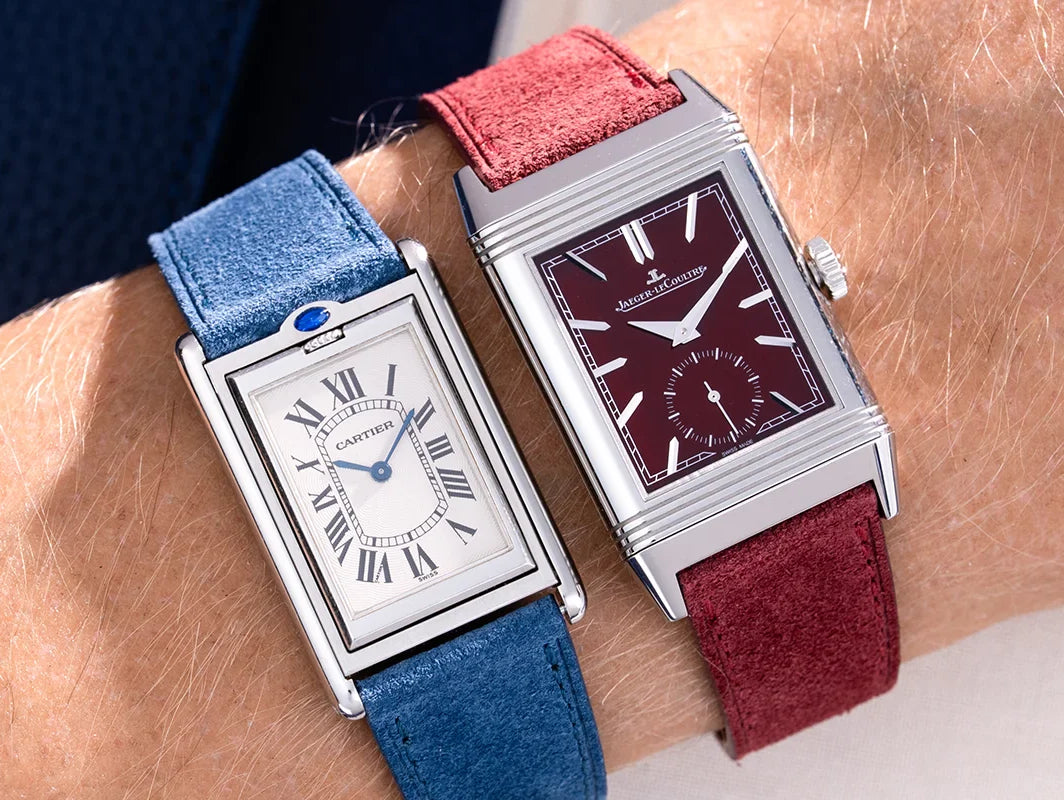Panerai ist eine jener Marken, die sich von der Masse abheben – markant, funktional und geschichtsträchtig. Doch um zu verstehen, was sie so besonders macht, müssen wir ganz von vorne beginnen.
Im Jahr 1860 eröffnete ein Mann namens Giovanni Panerai im italienischen Florenz ein kleines Geschäft. Es verkaufte Uhren, bot Reparaturen an und diente – einzigartig – als erste Uhrmacherschule der Stadt. Es war mehr als nur ein Geschäft. Es war der Beginn eines Familienerbes, das auf Präzision und praktischem Design beruhte.
Panerai-Geschichte: Ein Vermächtnis, das aus der Funktion geboren wurde
Giovannis Enkel, Guido Panerai, erweiterte das Unternehmen Anfang des 20. Jahrhunderts. Er erkannte die Chance, mit der königlich-italienischen Marine zusammenzuarbeiten und begann, Werkzeuge und Instrumente für sie zu entwickeln. Diese Partnerschaft sollte für Panerai von zentraler Bedeutung werden.
1916 stellte Panerai Radiomir vor, eine Leuchtmasse auf Radiumbasis. Sie leuchtete im Dunkeln und erleichterte so das Ablesen von Geräten bei schlechten Lichtverhältnissen oder unter Wasser. Obwohl sie ursprünglich für Werkzeuge und Messgeräte verwendet wurde, legte sie den Grundstein für die ikonischsten Uhren von Panerai.

Für den Kampf gebaut, nicht für den Handel
1936 benötigte die italienische Marine eine Armbanduhr, die für Taucheinsätze geeignet war. Panerai reagierte auf diesen Wunsch mit der ersten Radiomir-Uhr . Sie hatte ein großes, kissenförmiges Gehäuse und ein gut lesbares Zifferblatt. Rolex lieferte Gehäuse und Uhrwerk, während Panerai sich auf Zifferblatt und Montage konzentrierte.
Diese Uhren wurden als Gebrauchsuhren gebaut und von Kampftauchern der Eliteeinheit Decima Flottiglia MAS während des Zweiten Weltkriegs getragen. Bei ihrem Design ging es nicht um das Aussehen, sondern um Zuverlässigkeit unter härtesten Bedingungen.
Der Wechsel zu Luminor
In den 1950er Jahren wurden die Gefahren von Radium deutlich. Panerai entwickelte Luminor , ein sichereres Material auf Tritiumbasis, und brachte ein neues, passendes Gehäusedesign heraus.
Die aktualisierten Uhren verfügten über dickere Bandanstöße, eine Kronenschutzbrücke und das, was heute als „Sandwich-Zifferblatt“ bekannt ist. Dieser neue Look war mutig, funktional und sofort erkennbar – alles, wofür Panerai stand.
Die Rolex-Verbindung
Von den 1930er bis in die 1950er Jahre spielte Rolex eine Schlüsselrolle in der Entwicklung von Panerai. Dank der wasserdichten Oyster-Gehäuse und zuverlässigen mechanischen Uhrwerke konnte Panerai langlebige Uhren in Militärqualität herstellen.
Diese frühen Kooperationen zwischen Rolex und Panerai zählen heute zu den begehrtesten Vintage-Uhren der Welt. Sie repräsentieren einen Moment, in dem zwei legendäre Marken gemeinsam Herausforderungen der realen Welt lösten.
Der Tiefenmesser, den es nie gab
Im Jahr 1956 hatte Panerai eine Idee, die ihrer Zeit voraus war: eine Armbanduhr mit eingebautem Tiefenmesser . Die für ägyptische Militärtaucher entwickelte Uhr konnte die Unterwassertiefe ihres Trägers messen.
Obwohl es nie in Massenproduktion ging, zeigte das Konzept, dass Panerai schon immer wie Ingenieure dachte. Es ging nicht darum, schicke Uhren herzustellen, sondern darum, Probleme zu lösen.

Öffnung für die Öffentlichkeit
Bis 1993 wurden Panerai-Uhren nicht öffentlich verkauft. Sie wurden ausschließlich für militärische Zwecke hergestellt. Das änderte sich mit der Einführung der ersten kommerziellen Kollektion. Die Uhren waren weiterhin groß, markant und schlicht – genau wie die Militärversionen.
Kurz darauf entdeckte Sylvester Stallone Panerai bei Dreharbeiten in Rom. Er trug eine Uhr im Film „Daylight“ und bestellte sogar Sonderanfertigungen für Freunde. Diese Verbindung zu Hollywood trug dazu bei, die Marke einem völlig neuen Publikum bekannt zu machen.

Die Richemont-Ära
1997 wurde Panerai von der Richemont Group, einem globalen Luxuskonzern, übernommen. Dank der zusätzlichen Ressourcen erweiterte die Marke ihr Sortiment, entwickelte eigene Uhrwerke und eröffnete Boutiquen auf der ganzen Welt.
Trotz des Wachstums blieb Panerai seinen Wurzeln treu. Auch die neuesten Modelle spiegeln die ursprünglichen Prinzipien wider: Klarheit, Zuverlässigkeit und eine starke visuelle Identität.
Signature-Modelle
Radiomir 1936 – Die allererste Taucheruhr, die Panerai herstellte.
Luminor Marina – Bekannt für seinen Kronenschutz und das klare Zifferblatt.
Submersible – Eine moderne Version der robusten Taucheruhr.
Egiziano (GPF-2/56) – Gebaut für die ägyptische Marine. Riesig, unverwechselbar und selten.
Mehr als eine Uhrenmarke
Panerai hat sich im Laufe der Jahre eine treue Anhängerschaft erarbeitet. Eine globale Community, die sogenannten Paneristi , unterstützt die Marke weiterhin, angezogen von ihrem Design und ihrer zielorientierten Tradition.
Panerai folgt keinen Trends. Der Fokus liegt auf der Funktion. Diese Uhren sind für den Gebrauch gemacht – und genau deshalb verbinden sie eine so tiefe Verbindung zu ihren Besitzern.
Moderne Materialien, gleiche DNA
Auch heute noch ist Panerai innovativ. Die Marke verwendet fortschrittliche Materialien wie Carbotech und Fibratech und hat sich verpflichtet, recycelten Stahl zu verwenden und die Umweltbelastung zu verringern.
Trotz all dieser Neuerungen haben Panerai-Uhren immer noch den Eindruck, als seien sie für einen bestimmten Zweck gemacht. Sie sind auf Leistung ausgelegt – und auf Langlebigkeit.
Warum Panerai immer noch Anklang findet
Eine Panerai zu tragen ist anders. Es geht nicht nur um das Design – es geht um die Geschichte dahinter. Das Gewicht, die Form, die Schlichtheit – all das stammt aus einer Zeit, als Uhren für Missionen und nicht für Marketingzwecke hergestellt wurden.
Viele Panerai-Besitzer kombinieren ihre Uhr mit einem Panerai-Kautschukarmband , das für mehr Komfort und Flexibilität sorgt, ohne den robusten Charakter zu verlieren, für den die Marke bekannt ist.
Zusammenfassend: Panerai begann mit einem einfachen Ziel: zuverlässige Werkzeuge für Profis zu bauen. Heute ist die Marke ein Symbol für funktionsorientiertes Design und genießt das Vertrauen von Tauchern, Sammlern und Uhrenliebhabern auf der ganzen Welt. Ihre Geschichte ist nicht nur beeindruckend – sie spiegelt sich in jeder Uhr wider, die sie herstellt.



